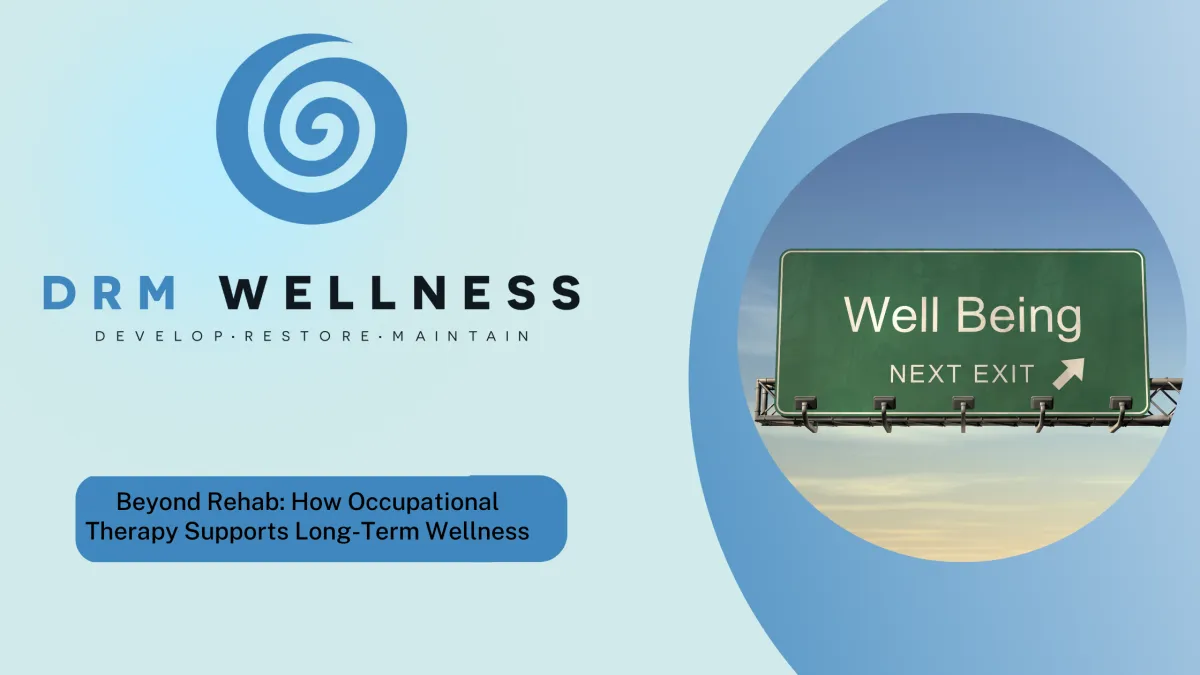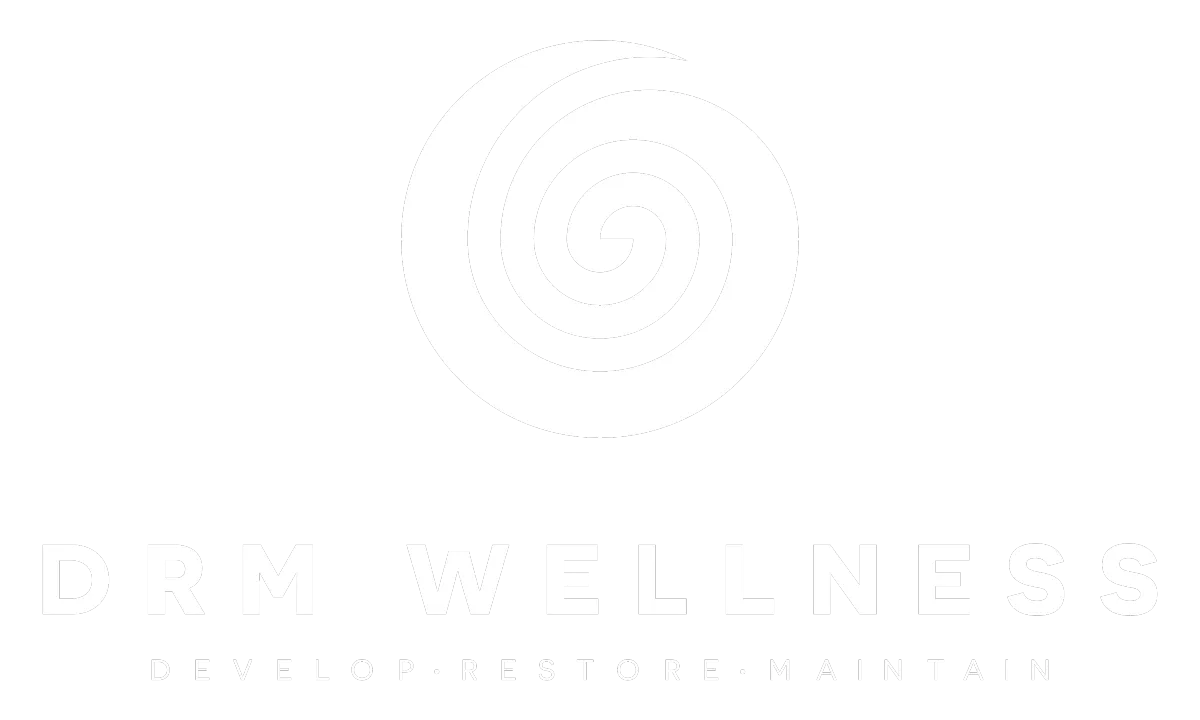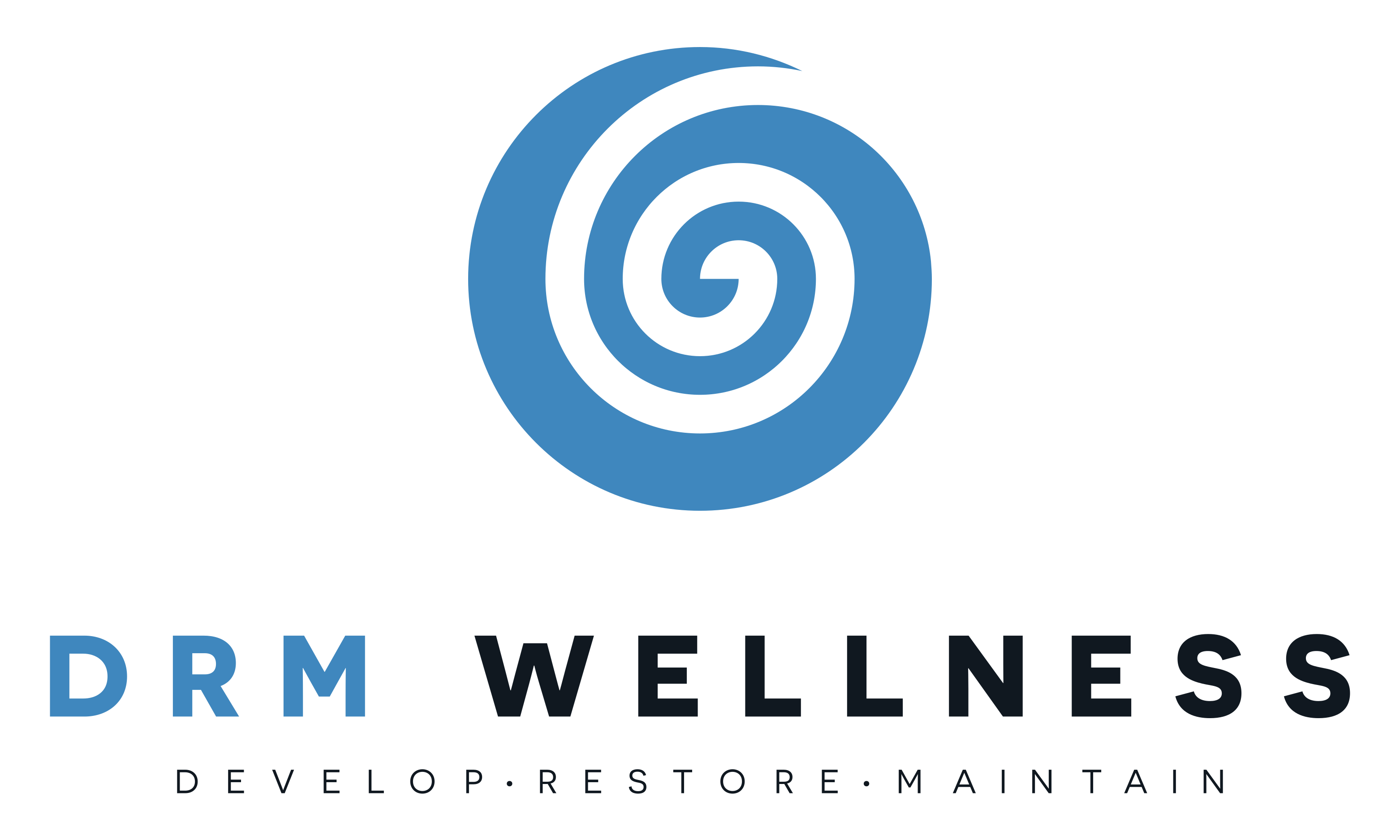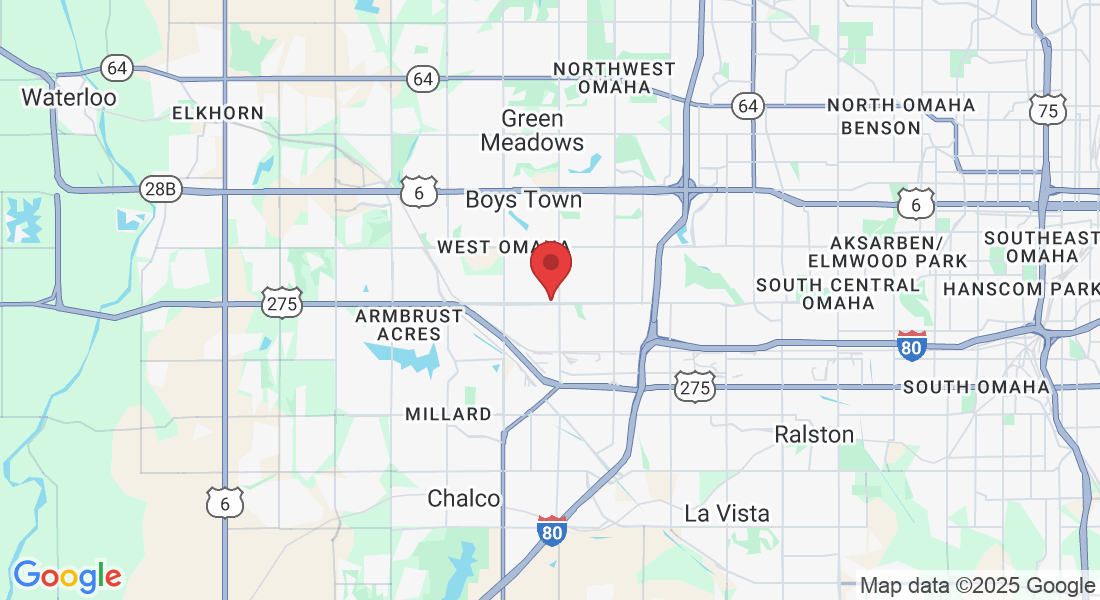Blogs
“When health meets heart, the conversation begins, and it starts here.
Knowledge that empowers. Stories that connect. Support that matters.”
~ DRM Wellness

Beyond Rehab: How Occupational Therapy Supports Long-Term Wellness
Beyond Rehab: How Occupational Therapy Supports Long-Term Wellness
When most people hear the words Occupational Therapy, they immediately think of recovery after an injury, surgery, or illness. While that is certainly part of what OTs do, it’s only one piece of the puzzle. Occupational therapy is not just about helping people get back to where they were, it’s about helping people move forward, live fully, and thrive in their daily lives.
OT Is About More Than Recovery
Traditional rehab often ends when insurance coverage runs out or when someone has reached “maximum medical improvement.” In other words, the medical system says, “You’re as good as you’re going to get.” However, life doesn’t stop there and your therapy does not have to stop there either. For many people, that’s when the hardest part actually begins.
So what happens after formal therapy ends? You’re still expected to cook your meals, manage your household, care for yourself, and get back to the activities you love. That’s where occupational therapy goes beyond the medical checklist. We don’t always have to stop at what insurance calls “basic function.” We can ask the bigger questions:
How do you want to live?
What activities bring meaning and purpose to your day?
What barriers are holding you back from independence?
What goals matter most to you, not just to your doctor or your insurance company?
The truth is, you can still have therapy even after your traditional rehab program ends. That’s the beauty of working with an occupational therapist in a wellness setting or with a mobile outpatient therapist like we are here at DRM. We continue the journey with you. Instead of focusing only on what you can’t do, we explore what you want to do.
From an insurance and Medicare standpoint, here’s what that means:
Medicare Part B Coverage – Many people think that once home health or inpatient rehab stops, therapy is no longer an option. That’s not true. Medicare Part B often covers outpatient occupational therapy if you continue to demonstrate medical necessity, meaning therapy is needed to help you maintain or improve function, prevent decline, or manage a chronic condition. This allows therapy to continue on a weekly or as-needed basis in a clinic or even in your home if a mobile practice (like DRM Wellness) is available.
Private Insurance – Commercial insurance plans vary, but many include outpatient therapy visits beyond the hospital or rehab stay. Even if the number of visits is capped, additional visits may be approved if your provider documents progress, ongoing needs, or safety concerns that would put you at risk without continued therapy.
Private Pay & Wellness Services – For those who have exhausted their covered visits or want to go beyond the “medical necessity” definition, private pay fills the gap. This allows you to keep working on your personal goals: fitness, strength, balance, independence at home..even when insurance no longer pays for it. Think of it as investing in your long-term health, not just a short-term fix.
The difference is this: Traditional rehab is designed to restore you to a baseline level of independence that insurance companies consider “functional.” A more wellness-based occupational therapy approach looks at the bigger picture. We address what matters to you, whether that’s climbing stairs without fear, getting back into the kitchen to cook, or keeping up with your grandkids.
At DRM Wellness, we bridge that gap. We work within insurance systems when possible, and when coverage ends, we provide flexible private pay and wellness options so therapy doesn’t have to stop when life still demands more of you.
Occupational therapy isn’t about doing exercises for the sake of exercises. It’s about creating solutions that fit your real life. For example:
Instead of just improving shoulder strength after surgery, we might focus on how you can safely reach into overhead cabinets again.
Instead of stopping therapy after a hip replacement because you can walk across the clinic, we help you figure out how to climb the stairs into your home, carry your laundry, or garden without fear.
Instead of leaving bariatric clients to figure out fitness alone, we provide safe, judgment-free ways to build strength and endurance that feel achievable and empowering.
From there, we build strategies, teach skills, and create environments that allow people to live with less pain, more confidence, and more joy. It’s not always about “getting back to normal.” It’s about building a new normal that works for your body, your lifestyle, and your goals.
Wellness That Extends Into Daily Life
One of the most powerful aspects of occupational therapy is that it focuses on real life. Health isn’t just about whether you can lift your arm to ninety degrees in a clinic or walk 100 feet down a hallway. It’s about how all those abilities come together when you’re living your day-to-day life. That’s where OT shines! We translate skills into independence.
Instead of looking only at a joint, a muscle, or a diagnosis, we step back and ask how your entire body, mind, and environment work together. Sometimes that means strengthening muscles, but often it means teaching strategies, making small adjustments, or rethinking the way tasks are done so life feels easier and safer.
Here’s what that looks like in action:
Cooking with confidence: Teaching safe ways to cook a meal without fear of dropping heavy pans or losing balance at the stove. Something as simple as adaptive handles, proper kitchen setup, or safer lifting techniques can restore independence in the heart of the home.
Judgment-free fitness: Helping a larger client move with more confidence during exercise and mobility. We use functional, approachable activities that build strength without shame.
Bathroom independence: Adapting a bathroom so an older adult can bathe without risk of falling. A few key changes like grab bars, non-slip mats, or a shower chair can transform a space from risky to empowering.
Support for caregivers: Working with a caregiver to reduce injury and strain while assisting a loved one. Lifting, transferring, and supporting someone physically can take a toll. OT helps caregivers protect their own health while providing safe, effective care.
Everyday movement as exercise: Building strength and endurance through functional activities instead of traditional gym workouts. Carrying laundry baskets, practicing sit-to-stands from a favorite chair, or walking the hallway can become part of a tailored wellness plan.
These aren’t abstract goals. They’re practical solutions that help people feel more confident in their own homes, more capable in their daily routines, and more connected to the activities that matter most. That’s what makes OT different. It doesn’t just help people recover, it helps them live well.
Prevention Is Just As Important as Recovery
A big part of long-term wellness is not waiting until something goes wrong. Too often, people only think about occupational therapy after an accident, surgery, or health scare. But prevention is just as critical as recovery. Falls, injuries, and hospitalizations don’t just “happen.” In many cases, they can be anticipated and reduced with the right strategies in place.
Occupational therapy takes a proactive approach by addressing risks before they turn into crises. That means looking at a person’s home, habits, routines, and physical abilities as a whole and making thoughtful adjustments to reduce risks and increase safety.
How OT Supports Prevention:
Home safety evaluations: The home should be a place of comfort, not danger. Unfortunately, many falls occur in living rooms, bathrooms, or kitchens that were never designed with aging or changing abilities in mind. An OT evaluation can identify hazards such as loose rugs, poor lighting, or cluttered pathways and provide practical solutions. Sometimes the fix is as simple as moving furniture, adding brighter bulbs, or storing everyday items within easy reach. These small adjustments can make the difference between a safe home and a serious injury.
Energy conservation techniques: Fatigue is one of the most common but overlooked risk factors for accidents. When people are tired, they take shortcuts, rush, or lose balance more easily. OTs teach strategies like pacing activities throughout the day, breaking tasks into smaller steps, sitting to complete chores instead of standing, and using adaptive equipment to reduce strain. By conserving energy, people maintain independence without burning themselves out.
Posture, ergonomics, and movement patterns: Many injuries develop slowly over time because of repeated strain or poor movement habits. Something as common as slouching at a desk, twisting awkwardly to lift laundry, or standing too long on hard surfaces can lead to chronic pain and eventual injury. OTs analyze these patterns and teach safer, more efficient ways to move. Adjusting desk height, improving body mechanics, or practicing safer lifting techniques can prevent years of discomfort.
Healthy routines for overall wellness: Prevention isn’t only about avoiding falls. Sleep quality, exercise, hydration, nutrition, and stress management all impact how well someone functions. OTs help people develop realistic daily routines that prioritize these habits in ways that actually fit their lifestyle. The goal is never perfection.. it’s sustainability. A consistent, manageable routine supports energy, strength, and long-term health.
At its core, prevention is about building resilience today to protect independence tomorrow. Every small change, whether it’s adding a grab bar, learning how to move more efficiently, or creating a healthier sleep routine, builds a stronger foundation for the future. When we focus on prevention, we’re not just avoiding accidents, we’re actively investing in independence, dignity, and quality of life.
OT for Every Stage of Life
Occupational therapy is not reserved only for seniors or for people recovering from surgery. It is for anyone who wants to live a fuller, healthier, more independent life. The strength of OT lies in its flexibility. It adapts to your needs, your goals, and your circumstances, no matter your age or stage of life.
Older adults:
For seniors, OT is often the bridge between independence and assisted living. Aging in place doesn’t just happen by chance, it requires planning, home modifications, and strategies for staying safe while completing everyday activities. An OT can evaluate the home for hazards, recommend adaptive equipment like grab bars or raised toilet seats, and teach ways to conserve energy while still enjoying daily routines. More importantly, OT provides peace of mind for both seniors and their families by focusing on safety and confidence.
Bariatric and plus-size clients:
Fitness and wellness often feel intimidating in traditional gyms, where equipment isn’t designed for larger bodies and where judgment or stigma can be a barrier. Occupational therapy offers a supportive, judgment-free environment where movement is adapted to fit the individual. We focus on functional fitness…building the strength, endurance, and mobility needed for real-life tasks like climbing stairs, carrying groceries, or getting up from the floor. OT empowers clients to focus on health and ability instead of numbers on a scale.
Caregivers:
Caring for another person is one of the hardest jobs on the planet, both physically and emotionally. Many caregivers experience back injuries, exhaustion, or burnout from constant lifting, transferring, or supporting their loved one. OT provides training in safe body mechanics, adaptive equipment to make transfers easier, and strategies to manage the daily demands of caregiving. By teaching caregivers to protect their own health, OT ensures they can continue providing care safely and sustainably.
Professionals:
Work today often means long hours at a desk or repetitive tasks that strain the body over time. Headaches, back pain, carpal tunnel, and neck stiffness are common results of poor ergonomics. OT helps professionals create healthier workstations, adjust posture, and build movement breaks into their day. These small changes reduce discomfort, increase productivity, and prevent long-term injury, allowing people to keep working effectively without sacrificing their health.
Individuals with chronic conditions:
Living with a chronic condition such as arthritis, Parkinson’s disease, multiple sclerosis, or chronic pain can make daily life unpredictable. OT steps in to create realistic strategies that balance activity and rest, reduce strain on joints, and conserve energy. This might mean teaching new ways to dress, cook, or manage chores, or introducing adaptive tools that make life easier. The goal isn’t just to cope, it’s to live fully within the realities of the condition.
Wherever you are in life, OT meets you there. It adapts to your current challenges and helps you take the next step forward, whether that means recovering from an illness, managing a lifelong condition, or simply finding better ways to thrive in your everyday world.
A Partner in Lifelong Wellness
Occupational therapy is not about quick fixes or one-size-fits-all solutions. It’s about creating lasting change through partnership. At its core, OT is collaborative. We don’t just hand you a list of exercises or recommendations and send you on your way. We walk alongside you. Together, we problem-solve, adapt, and build strategies that support you in living the life you want, not just the life you’re left with after illness, injury, or change.
At DRM Wellness, our mission is to help clients develop skills, restore function, and maintain health and independence. Not just today, but for years to come. That means:
Helping people recover from injury or surgery while also teaching them how to prevent future setbacks.
Supporting clients in achieving their personal goals, not just checking off a box for insurance or a medical chart.
Creating solutions that are practical, sustainable, and tailored to real life, not generic plans that don’t fit your home, your body, or your lifestyle.
The beauty of occupational therapy is its ability to evolve with you. Your needs may change as you age, as your health shifts, or as life circumstances bring new challenges. OT adapts right along with you. Whether you are learning how to safely bathe after joint replacement surgery, building strength and endurance as a bariatric client, or setting up your home to age in place, OT is a partner for every stage.
Wellness is not a destination. It’s a journey, and you don’t have to navigate it alone. With occupational therapy, you gain a partner who is invested in your independence, your dignity, and your ability to live life on your own terms.
At DRM Wellness, we believe that OT should extend well beyond the walls of traditional rehab, although we do see traditional rehabilitation clients for therapy, helping them recover from surgeries, injuries, or medical setbacks. Our focus is also on supporting long-term wellness, independence, and confidence at every stage of life.
If you have any questions, we would love to talk to you about we can help. Take the next step toward living life on your terms. Call us today at (402) 940-8181, email [email protected], or visit www.DRMwellness.org to schedule your consultation. Let’s develop skills, restore function, and maintain your health & independence…together.
Take The Next Step with DRM Wellness
Testimonials

MEDICAL DISCLAIMER:
All information on this website is intended for instruction and informational purposes only. The authors are not responsible for any harm or injury that may result. Significant injury risk is possible if you do not follow due diligence and seek suitable professional advice about your injury.
No guarantees of specific results are expressly made or implied on this website.
Copyright © 2025 All Rights Reserved by DRM Wellness.



Facebook
Instagram
LinkedIn
Youtube
TikTok